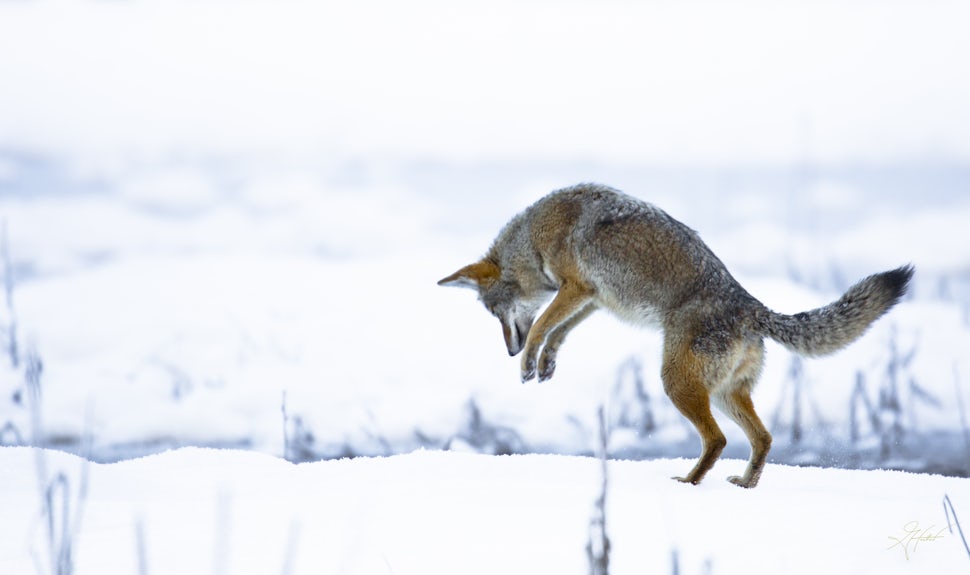Searching for Winter Wildlife in Yosemite Valley
Viewing winter wildlife in Yosemite Valley is all about timing. Here are some tips for when and where to find wildlife, how to photograph them, and what animals to expect.

Wildlife in Yosemite Valley is vastly different according to seasons. Bears will be in hibernation, antlers will have been shed for the season, but there are a few stars to keep your eyes peeled for. Most notably, the hunting coyotes.
Coyotes spend most of their time avoiding humans (we have that in common). and do most of their winter hunting in the valley. That being said, they will usually be searching for breakfast very early and in the peaceful hours of dawn. Avoiding tourists is a major factor in their hunting process.

Half Dome Village is closest to the trees lining the valley floor and also nearest to the campsites. The coyotes quietly patrol the campsites in the middle of the night hoping for potential scraps. So they navigate to the Half Dome Village in the mornings due to proximity....then go back into hiding while the humans wander the park.

The National Parks Service is really great in Yosemite about not allowing any garbage or food to be left out in order to protect these animals. They don't want to have to hurt any animals just because some doofus tourists left some food on the table. RIP Harambe.

If you are lucky, you may come across the most elusive animal in the park, the bobcat. I still have yet to see one. I've heard a mountain lion may be spotted in the valley as well. These cats are afraid of humans and are smart to keep a safe distance.
You will, however, have a great chance to get close to the tamest mule deer on earth. This skittish animal by nature will always be best viewed in the morning hours. You would be skittish by nature too if "everything" is "always" trying to kill you. They know they are safe from hunting in Yosemite.

Deer come to life in the mornings and it is your best bet to rise with the sun and begin your search for the animals. Usually hanging out in El Capitan Valley, and along the Merced River where water is always present. The morning is always the calmest and quietest hours, deer thrive on their sense of hearing for safety.

Eagles, owls, stellar jays, woodpeckers and many other birds will be foraging the valley as well, usually along the Merced River as well. Loudly, the ravens will be making an appearance at your campsite as they are pure scavengers.

As a rule in winter, the hours of dawn and dusk are when the animals are most active. 75% in the mornings.
I want to make a quick note about camera settings. For wildlife, shutter speed is your most important ally. Do the best you can do with your lighting conditions, but, you generally want to be shooting at least 1/1000th of a second, in order to freeze motion properly. With birds, and splashing water, 1/2000th of a second will do.
Yes, they are wildly expensive...but, investing in a telephoto lens with the lowest possible aperture is very important if you are serious about shooting wildlife.
The lower the aperture means that more light is allowed in so that you can achieve higher shutter speeds.
Everybody remembers that Speilberg scene from Jurassic Park when the girl shines the flashlight in the T-Rex eye. Mind blowing stuff, Steven. "TURN THE LIGHT OFF!" That moment in film was a science lesson, and in this case, That moment explains aperture.
Think of it like your eye ball. A camera lens is a technological re-creation of the human eye, once we fully understood the science of it. When you shine a bright light into your eye, your pupil shrinks. When it is dark, your pupils dilate. This is what aperture is. You want your "pupil size" to stay large, even in bright light, so then your camera "brain" can voluntarily adjust the shutter speed. At night when your camera gets motion blurry, it's because low light is forcing the shutter speed to slow wayyyyy down. Comprende?
No intent to patronize. It took me years to understand the aperture and the F-stop language. All lessons aside, do your best (sell your car) to get your hands on a 2.8 lens.
#theoutbound #everyoneoutside
PACK LIST
Merino Wool Socks (best socks on Earth). I love the brand "Fun Toes"
Waterproof Boots, Cold Weather Clothing, Fingerless Gloves (for camera operations)
Camera, Telephoto Lens, Tripod, Binoculars
We want to acknowledge and thank the past, present, and future generations of all Native Nations and Indigenous Peoples whose ancestral lands we travel, explore, and play on. Always practice Leave No Trace ethics on your adventures and follow local regulations. Please explore responsibly!
Do you love the outdoors?
Yep, us too. That's why we send you the best local adventures, stories, and expert advice, right to your inbox.








